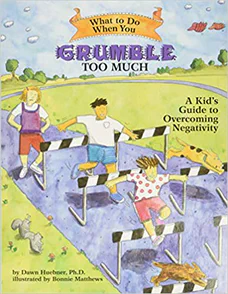What to Do When You Grumble Too Much
A Kid’s Guide to Overcoming Negativity
Written by Dawn Huebner, Ph.D.
Illustrated by Bonnie Matthews
88 pages
•
Published 2006 (Magination Press)

Recommended Age Range: 1st grade through 5th grade.
Publisher's Summary:
What to Do When You Grumble Too Much guides children and their parents through the cognitive-behavioral techniques used to treat negative thinking. Lively metaphors and illustrations help kids see life’s hurdles in a new way, while drawing and writing activities help them master skills to get over those hurdles. And step-by-step instructions point the way toward becoming happier, more positive kids.

Dr. Annie's Takeaways
Recommended for: I would recommend this interactive workbook for a child who would like to feel more resilient when things don’t go their way and who won’t be totally thrown off by the (fairly judgmental) title. The interventions in this workbook predominantly focus on cognitive restructuring
, which requires a child be able to articulate their thoughts to some extent. In most situations, I’d recommend a different book on problem solving, flexible thinking
, and/or frustration tolerance
, but for a primer on strategies that address glass-half-empty thinking patterns, this workbook could be useful. The obstacle course metphor that Dr. Huebner uses is effective and fun.
Would a child like it? Zero percent of children enjoy being told that they’re grumbling too much. If a child is able to get past this set-up, they may enjoy learning that how they are feeling isn’t totally dependent on factors external to themselves.
Evidence-Based Practices:
Cognitive Restructuring
Tone: Instructive, encouraging
Story Quality: This book uses an effective metaphor of an obstacle course (they’re fun if you know how to navigate the obstacles!) to motivate children to practice shifting their thinking and strengthening their problem solving skills. Dr. Huebner’s writing is clear and developmentally appropriate, and there are fairly engaging hands-on activities for a child to complete in the workbook (e.g., writing out the “good parts” and “bad parts” of different situations). My primary–and significant–criticism is the use of “grumbling too much” as the description of the problem. Most children don’t view grumbling as the problem (and nor do I, in the vast majority of cases). More on that later.
Illustrations: Black and white watercolor cartoons to accompany the text.
Representation: Children with different skin tones, hair, and genders are portrayed in the illustrations throughout the text. A few examples include mentions of Mom or of Dad. The metaphors and activities included assume that the child reading the book is able to run, jump, and stretch their body.
Psychological Practices: This book is designed to specifically address overly negative thinking patterns, primarily through the use of different cognitive restructuring
techniques. Negative thinking patterns can increase a child’s risk of depression, anxiety, and emotion regulation
challenges but are not diagnostic in and of themselves. This book covers the connection between one’s thoughts and feelings (e.g., if you see a glass as half full, you’ll feel happier), the benefits of intentionally noticing good things about a situation (i.e., “strengthen[ing] the positive part of your brain”), practice being flexible (problem solving, shifting attention), coaching parents to validate the child’s concerns and prompt shifts in thinking, a visualization to decrease past-focused rumination (dropping the “bad memories backpack”), ideas for taking a break when angry, and an activity to collect positive memories. The most effective parts of this book help a child realize that they actually have some control over how they feel about a situation (e.g., by shifting their thinking or problem solving), which can be very empowering to a kid who feels that nothing ever goes the way they want it to.
Concerns: I really wish this book were called What to Do When Things Never Go Your Way. Many of the same exercises would apply–problem solving, flexible thinking, etc. But it would be less critical of the child reading the book, children would feel less defensive reading it, and it would better address what I see as the underlying problems. From my perspective, the primary problem isn’t grumbling–although parents and teachers may disagree. The problem is that a grumbly child feels that things need to be exactly right in order for them to feel okay, and this is a VERY unsettling feeling for a child who has little control over what happens to them. I wish the stated goal of the book were to help children to feel more in control and more resilient when things don’t go their way, rather than helping them to grumble less. Grumbly children are often told that they’re ruining things when they’re feeling upset, even though said thing has already been ruined for them, and criticizing them for this isn’t helpful. Additionally, I have some concerns about the activity described as dropping the bad memories backpack. I think the intention is to decrease rumination, which is a good goal. But I would be very careful when talking with a child about this. I would want to make sure that the bad memories to leave behind are things like getting their second choice ice cream flavor and not something more serious (e.g., trauma-related). This intervention runs dangerously close to the recommendation to stop thinking about something and move on, which can be impossible and harmful advice for someone who has experienced a serious loss or trauma. It’s also usually much more effective to help a child shift their attention toward something rather than away from something.
